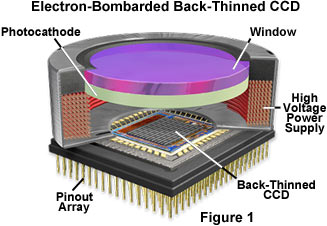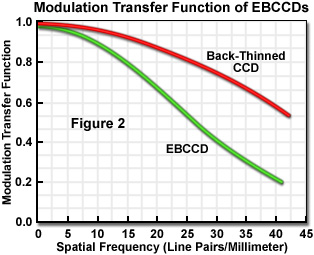Concepts in Digital Imaging Technology
Electron-Bombarded Charge-Coupled Devices (EBCCDs)
The electron-bombarded charge-coupled device (EBCCD) is a hybrid of the image intensifier and the CCD camera that is useful in fluorescence microscopy for imaging specimens at very low light levels. In this device, photons are detected by a photocathode similar to that in an image intensifier. The released electrons are accelerated across a gap and impact on the rear side of a back-thinned CCD.

These energetic electrons generate multiple charges in the CCD resulting in a modest gain of a few hundred. Figure 1 illustrates the design of an electron-bombarded CCD in which photoelectrons, accelerated by a high voltage gradient (1.5-2.0 kilovolts), impact directly onto a back-thinned CCD operating at video rate.
| Interactive Java Tutorial | |||||||||||
|
|||||||||||
The advantages of this device over a cooled, slow-scan CCD are the additional gain and accompanying speed. EBCCDs also demonstrate no significant geometrical distortion or shading, relatively low noise (40 electrons/pixel) because of design improvements in CCD read-out, on-chip integration capability, and the option for a variety of read-out rates and formats such as binning and subsampling. The main disadvantages are the lower quantum efficiency of the photocathode (30 percent) compared to that of an unmodified back-thinned CCD (80 to 90 percent) and a significant degradation in the modulation transfer function compared to that of the back-thinned CCD alone (see Figure 2).

Limitation of the dynamic range of the EBCCD is also a consequence of the increased gain. This occurs because each photoelectron generates approximately 300 electron/hole pairs causing the wells fill 300 times faster than in an ordinary CCD. The result is that a CCD having a full-well capacity of 150,000 electrons is completely filled by only 500 photons.
Compared to an intensified CCD, the electron-bombarded CCD usually has higher spatial resolution and a better signal-to-noise ratio at moderate light levels, but the limited gain adjustment range and modest low-light-level detection capability make the EBCCD the solid-state equivalent of the outmoded silicon intensifier target (SIT) camera.
Contributing Authors
Kenneth R. Spring - Scientific Consultant, Lusby, Maryland, 20657.
Michael W. Davidson - National High Magnetic Field Laboratory, 1800 East Paul Dirac Dr., The Florida State University, Tallahassee, Florida, 32310.
BACK TO CONCEPTS IN DIGITAL IMAGING TECHNOLOGY
